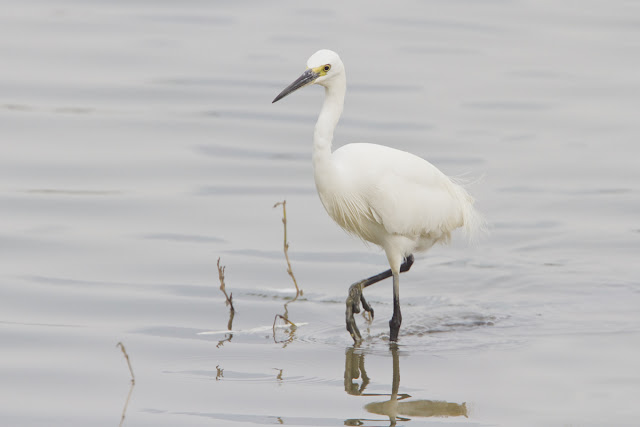I myself have never been a keen wader watcher, nor a particularly skilled one. But once in a while I still need to sharpen my skills to keep my wader knowledge from rusting. So, I took that up today and spent a day at Mai Po. Things were pretty quiet to begin with, a juvenile Purple Heron perched on a mangrove tree near the entrance.
Purple Heron
I headed towards pond 16 & 17 and found flocks of waders congregating. On my way a friendly Greenshank greeted me. I got into bird hide number 5 and found the scrape covered with waders, a truly wonderful sight to behold and we who live in Hong Kong are truly privileged to have this spectacle right at our doorstep.
Greenshank - the friendly one
Waders at Mai Po
The first interesting bird I found while scanning the scrape was a single Little Tern, a species I usually see in Spring. This time I get to see one in non-breeding plumage. It was pretty far away, only manage a record shot. At a glance I found the following: Pied Avocets, Black-winged Stilts, Little-ringed Plovers, Greater Sand Plover, Whimbrels, Black-tailed Godwits, Redshanks, Spotted Redshanks, Marsh Sandpipers, Greenshanks, Great Knots, a single Terek Sandpiper and Dunlins.
Little Tern
Scanning further I found a few Far Eastern Curlews amongst the Eurasian Curlew, here is a distant flight shot I managed, you can clearly see the difference. Suddenly the whole flock of waders took to the air, all crying and calling loudly. It's always spectacular to see thousands of waders take flight at the same time. All birders will learn to recognise this as a sign of an incoming raptor, everyone in the bird hide looked up at an instance.
Far Eastern Curlew - comparison shot with Eurasian Curlew
Black-tailed Godwits - mostly
Greenshanks in flight
Surely, right above us was an Eastern Marsh Harrier, circling around looking for a quick meal. It didn't manage to catch anything this time however and drifted slowly away.
Eastern Marsh Harrier
After the commotion, I went back to scanning the waders once the birds settled down. I didn't find anything of much interest. A Little Egret kept fluttering about in front of the bird hide, asking desperately to have a photograph taken. A Chinese Spot-billed Duck swam past.
Little Egret
Chinese Spot-billed Duck
I finally spotted something remotely interesting, a single Long-billed Dowitcher. This wader is a scarce migrant and winter visitor to Hong Kong. Breeding in Alaska and Northern Russia, most of the population winters in America, while a small population winters in Asia. The bird was pretty far away, therefore another record shot.
Long-billed Dowitcher
A flock of Spoonbills were also present, they have only recently return to Hong Kong from their breeding grounds. Close inspection revealed two Eurasian Spoonbills amongst the small flock, we get much fewer Eurasian Spoonbills in Hong Kong, although Black-faced Spoonbills are much rarer globally.
Flock of Spoonbills
Black-faced Spoonbill
Eurasian Spoonbill
The waders slowly flew away flock after flock, most will return to the mudflats to feed in the retreating tide. Nothing much were around for the rest of the way, a Cinerous Tit posed on the metal fence, my first Eastern Buzzard this season and a Pied Kingfisher performing it's party trick (hovering) in front of the bird hide.
Cinerous Tit
Eastern Buzzard
Pied Kingfisher
After Mai Po I saw that I still had a bit of time before I had other business to attend, so I dropped by Long Valley very quickly. The short visit was relatively productive. Three Yellow-breasted Buntings and a Chestnut-eard Bunting. I finally connected with the Black-headed Bunting that's supposedly been around for sometime! This species used to be very rare in Hong Kong, but ever since they re-introduced paddy fields into Long Valley, this species have became a regular visitor. While walking a long the tracks, I flushed a small Quail, I quickly picked up my bins before it landed and found myself clearly looking at a Yellow-legged Button-Quail! It was however unfortunate that after two flushing I could not locate it and it flew right into some dense vegetation (It flew right out from the side of my boots at one point!). However brief the encounter was, I still consider this a lucky one!
Black-headed Bunting










































































